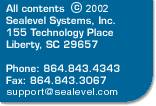Package Delivery
Major Delivery Service Uses Sealevel Boards In Coordinating Deliveries.
 For more than eight years Sealevel boards have been a mission-critical component used by a multi-billion dollar transportation company. This company runs a global network to deliver packages and freight. Because they were upgrading the company's delivery monitoring and management software to Windows 2000 they needed a new, PCI-based RS-485 serial solution. The user came back to Sealevel because of the pro-active technical support they had received in the past. For more than eight years Sealevel boards have been a mission-critical component used by a multi-billion dollar transportation company. This company runs a global network to deliver packages and freight. Because they were upgrading the company's delivery monitoring and management software to Windows 2000 they needed a new, PCI-based RS-485 serial solution. The user came back to Sealevel because of the pro-active technical support they had received in the past.
Racked Computers Used for Tracking Deliveries
 The original application consists of a DOS-based 486 host and a "quad rack" at each shipping depot. During the night, pad-style computers are shoed in the rack and the company upgrades their contents and makes any software changes required. In addition, their internal batteries are charged. Each quad rack has an RS-485 bus. Both of the two RS-485 ports on a host PC can communicate with eight racks, each with four pad-style computers in it. This means that with two strings of eight racks the host computer can communicate with a total of 64 computers over the RS-485 bus. The original application consists of a DOS-based 486 host and a "quad rack" at each shipping depot. During the night, pad-style computers are shoed in the rack and the company upgrades their contents and makes any software changes required. In addition, their internal batteries are charged. Each quad rack has an RS-485 bus. Both of the two RS-485 ports on a host PC can communicate with eight racks, each with four pad-style computers in it. This means that with two strings of eight racks the host computer can communicate with a total of 64 computers over the RS-485 bus.
In the morning, each delivery person retrieves their computer from the rack and uses it during the workday to manage their work, trace packages, create labels and report status of deliveries along their route. The original version of the system was developed and installed in the early 1990's, and the company uses it to manage approximately 90,000 portable computers.
 Updating to Windows 2000 With Sealevel PCI Bus Ports Updating to Windows 2000 With Sealevel PCI Bus Ports
When it was first built, this system used Sealevel 3082 and 3089 Dual Port RS-422/485 adapters on each of the host computers to communicate with the racked computers. Sealevel continues to make this ISA-bus hardware available, but for the user, upgrading to PCI-based hardware for Windows 2000 meant that this would no longer be an option. However, there was no question about who would supply the new card when the time came to make the switchover to PCI-bus cards.
The project manager at the user company explains the decision in very direct terms: "Sealevel has always been very proactive in terms of their support. They always wanted to ensure that their products worked well. That's why we chose their new Model 7201 for the upgrade to the system."
Because some of the user's existing equipment is aging, it can cause CRC errors so that data is not arriving at the destination the way it was sent. The fault can be bad cables, defective connectors and so forth, and one bad unit in a quad rack can create bad or spurious signals for other computers hosted there.
For the project manager, the Sealevel response to this problem was simply what he had come to expect: "When we were developing the new system they asked us to send us the entire hardware setup so they could test run it in their lab. As a result, they were able to recommend a number of ways to prevent these communications errors from occurring."
Eight years of proven reliability, pro-active technical support and technological expertise won this user's loyalty-and enabled them to deliver on time to the many millions of their own customers.
|


